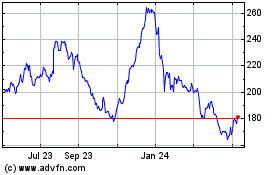Boeing's 737 MAX Another Step Closer to Resuming Commercial Flights
September 13 2020 - 10:29AM
Dow Jones News
By Andy Pasztor
European air-safety regulators have provided a subtle but
important vote of confidence for plans to eventually end the
grounding of Boeing Co.'s 737 MAX jets.
And their stance could help ease the regulatory logjam that for
more than a year has bedeviled the Chicago plane maker's efforts to
get the MAX back in the air.
The European Union Aviation Safety Agency on Friday signaled it
was satisfied with software and hardware fixes devised by Boeing --
and preliminarily approved by the U.S. Federal Aviation
Administration -- aimed at returning Boeing's 737 MAX fleet to
commercial service late this year.
After completing their own certification flights, European
safety regulators said they were analyzing data gathered during
those tests without elaborating. But the agency also gave a sign it
was generally comfortable with the flight results so far by
simultaneously announcing its intention to participate with a group
of American and international airline pilots scheduled to start a
round of ground-simulator tests outside London this week.
The tests will establish binding minimum training requirements
for pilots, including the length of extra ground-simulator sessions
before they can slide behind the controls of revised MAX jetliners.
Two fatal MAX crashes in less than five months prompted the March
2019 grounding of the global fleet.
European regulators said they continued working steadily, "in
close cooperation with the FAA and Boeing, to return the Boeing 737
MAX aircraft to service as soon as possible." But they reiterated
that will occur "only once we are convinced it is safe."
If the multinational tests go well, however, the 737 MAX will
have cleared the last major hurdle to starting to resume
operations.
Canadian aviation authorities also have independently flown test
flights and are preparing to send Canadian pilots to next week's
simulator sessions, which will include representatives of U.S. and
Brazilian airline pilots along with FAA representatives.
When those sessions end later this month, the FAA plans to
answer public comments. Agency chief Steve Dickson is slated to fly
the plane and the FAA's training experts are supposed to formally
establish changes to training procedures, emergency checklists and
MAX manuals. A separate group of FAA-chartered outside technical
experts will assess whether the software and hardware fixes meet
federal safety standards.
After those steps are completed, perhaps as soon as late
October, airlines will need to complete their own inspections,
maintenance procedures and official operational flight checks
before commercial MAX operations can resume.
Current industry and U.S. government estimates say all that
could happen in time to start limited MAX operations before the end
of the year. Boeing has said it expects to resume MAX deliveries
sometime during the fourth quarter. The FAA has said it won't sign
an order ungrounding the fleet until all safety issues are
resolved.
In a break from past practice which could delay Boeing's
turnover of new jets to airline customers world-wide, the FAA plans
to retain authority to issue airworthiness and export certificates
for all 737 MAX airplanes manufactured since the March 2019
grounding. FAA officials will perform in-person, individual reviews
of such aircraft, a job that was previously delegated to Boeing.
Such a process could delay a final decision in light of
public-health restrictions stemming from the coronavirus
pandemic.
Canadian and European regulators are expected to give the green
light to the MAX days or weeks after the FAA's decision, according
to industry and government officials tracking the issue. How long
it will take China to follow isn't clear, particularly because
Beijing officials haven't been closely involved in some of the
cross-border deliberations.
U.S. and foreign pilots and regulators also have stressed that
last-minute challenges and complications could extend the timeline
once again, as they have disrupted various proposed timetables
stretching back more than a year.
Even after the MAX resumes service, though, Boeing and the FAA
will continue analyzing ways to include additional, long-term
safety features on the aircraft demanded by Canadian and European
authorities.
(END) Dow Jones Newswires
September 13, 2020 11:14 ET (15:14 GMT)
Copyright (c) 2020 Dow Jones & Company, Inc.
Boeing (NYSE:BA)
Historical Stock Chart
From Mar 2024 to Apr 2024

Boeing (NYSE:BA)
Historical Stock Chart
From Apr 2023 to Apr 2024
